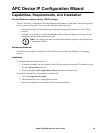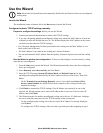
69InRow RC/RD/RP (600 mm) User’s Guide
Instructions for using SCP. To use Secure CoPy (SCP) to upgrade the firmware for one cooling unit:
1. Identify and locate the firmware modules described in the preceding instructions for FTP.
2. Use an SCP command line to transfer the AOS firmware module to the cooling unit. The
following example assumes a cooling unit’s IP address of 158.205.6.185, and an AOS module of
apc_hw03_aos_xxx.bin. (with
xxx representing the version number of the AOS module, with no
periods separating the digits).
scp apc_hw03_aos_xxx.bin apc@158.205.6.185:apc_hw03_aos_xxx.bin
3. Use a similar SCP command line, with the name of the application module instead of the AOS
module, to transfer the application module to the cooling unit.
Upgrade multiple cooling units
Export configuration settings. You can create batch files and use an APC utility to retrieve
configuration settings from multiple cooling units and export them to other cooling units.
Use FTP or SCP to upgrade multiple cooling units. To upgrade multiple cooling units using an
FTP client or using SCP, write a script which automatically performs the procedure. For FTP, use the
steps in “Use FTP or SCP to upgrade one cooling unit” in the script.
Use XMODEM to upgrade one cooling unit
To use XMODEM to upgrade the firmware for a single cooling unit that is not on the network:
1. Obtain the individual firmware modules (the AOS module and the application module) from
www.apc.com/tools/download.
2. Select a serial port at the local computer and disable any service which uses that port.
3. Connect the configuration cable (APC part number 940-0103) that came with the cooling unit to
the selected port and to the serial port at the cooling unit.
4. Run a terminal program (such as HyperTerminal), and configure the selected port for 9600 bps, 8
data bits, no parity, 1 stop bit, no flow control, and save the changes.
5. Press
ENTER twice to display the User Name prompt.
6. Enter the Administrator user name and password (apc by default for both).
7. From the Control Console menu, select System, then Tools, then File Transfer, then
XMODEM; and type
Yes at the prompt to continue.
8. At the prompt for the baud rate, enter an appropriate baud rate for the terminal program to use for
the transfer. A higher baud rate causes faster firmware upgrades.
See Release Notes: ini File Utility, version 1.0 on the Utility CD.
Note: Allowed values are 2400, 9600, 19200, and 38400. To choose a baud rate
different from your current connection, disconnect from the terminal session.
Configure the selected port for the desired baud rate and reconnect the terminal
session.


















